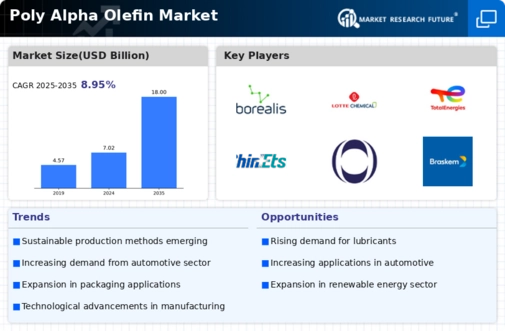Market Trends and Projections
Increasing Focus on Sustainability
The Global Poly Alpha Olefin Market Industry is witnessing a shift towards sustainability, as industries increasingly prioritize eco-friendly materials and processes. The demand for sustainable products is driving the development of bio-based Poly Alpha Olefins, which offer similar performance characteristics while reducing environmental impact. This trend aligns with global efforts to minimize carbon footprints and promote circular economy practices. As companies adopt more sustainable practices, the market for Poly Alpha Olefins is expected to grow, reflecting the changing preferences of consumers and industries alike.
Expansion in Oil and Gas Applications
The Global Poly Alpha Olefin Market Industry benefits from its expanding applications in the oil and gas sector. Poly Alpha Olefins are increasingly used as base oils in high-performance lubricants, which are essential for enhancing the efficiency of drilling and production operations. The shift towards more environmentally friendly and efficient lubricants is likely to drive the adoption of Poly Alpha Olefins in this sector. As a result, the market is anticipated to witness robust growth, with estimates suggesting a compound annual growth rate of 8.95% from 2025 to 2035, reflecting the increasing reliance on advanced materials in oil and gas applications.
Growing Demand from Automotive Sector
The Global Poly Alpha Olefin Market Industry experiences a notable surge in demand from the automotive sector, driven by the increasing need for lightweight and high-performance materials. Poly Alpha Olefins are utilized in various automotive applications, including engine oils and lubricants, due to their superior thermal stability and low volatility. As the automotive industry continues to evolve towards more efficient and sustainable solutions, the demand for Poly Alpha Olefins is projected to rise significantly. This trend is expected to contribute to the market's growth, with projections indicating a market value of 7.02 USD Billion in 2024.
Rising Demand for Synthetic Lubricants
The Global Poly Alpha Olefin Market Industry is significantly influenced by the rising demand for synthetic lubricants across various industries. Synthetic lubricants, which offer superior performance compared to conventional mineral oils, are increasingly favored for their enhanced thermal stability and reduced environmental impact. Industries such as manufacturing, automotive, and aerospace are progressively adopting these lubricants to improve operational efficiency and reduce maintenance costs. This shift is expected to propel the market forward, with projections indicating a market value of 18.0 USD Billion by 2035, highlighting the growing preference for high-performance synthetic solutions.
Technological Advancements in Production Processes
The Global Poly Alpha Olefin Market Industry is poised for growth due to ongoing technological advancements in production processes. Innovations in polymerization techniques and catalyst development are enhancing the efficiency and cost-effectiveness of Poly Alpha Olefin manufacturing. These advancements not only improve product quality but also enable manufacturers to meet the increasing demand for customized solutions across various applications. As production processes become more streamlined, the market is likely to expand, catering to diverse industrial needs and contributing to the overall growth trajectory of the industry.























